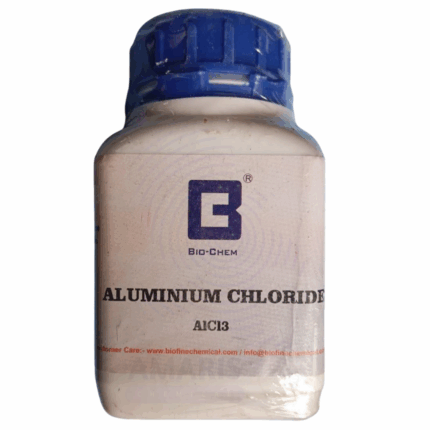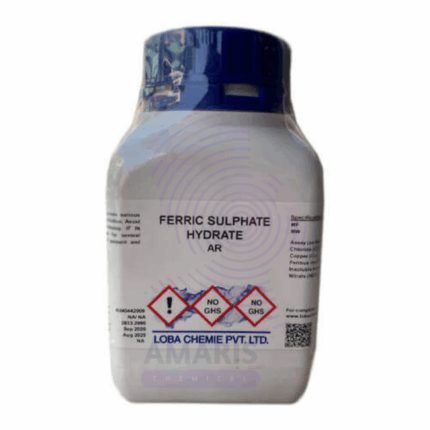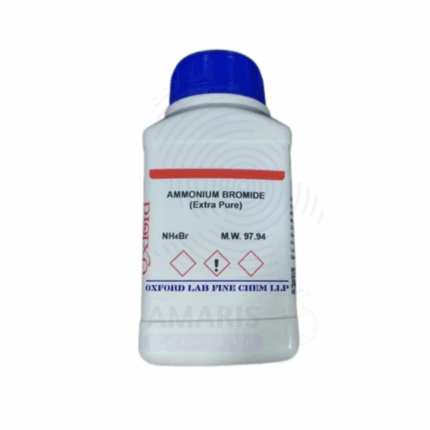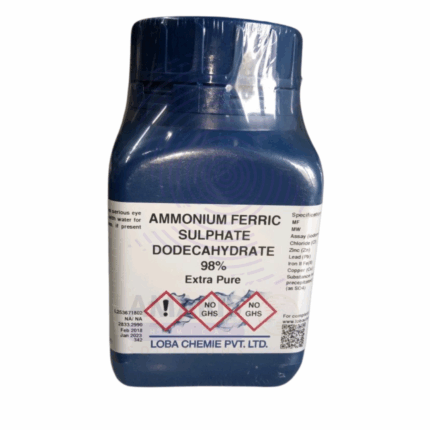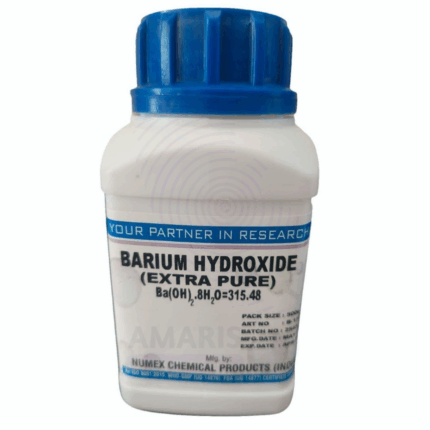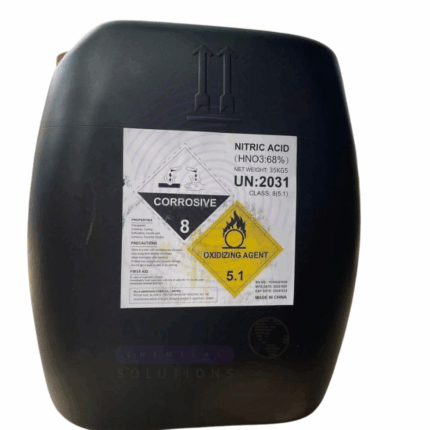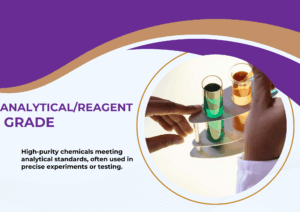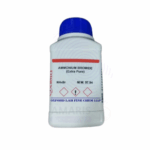
Ammonium Acetate Extra Pure
$ 18.00 Original price was: $ 18.00.$ 17.98Current price is: $ 17.98.
Ammonium Acetate Extra Pure is a high-purity, white crystalline solid that is highly soluble in water and commonly used as a buffer component in laboratory and analytical chemistry. It is especially valuable in high-performance liquid chromatography (HPLC), mass spectrometry, and biochemical assays where pH control and minimal ionic interference are essential. This compound also serves as a reagent in organic synthesis, particularly in the preparation of acetamides and other nitrogen-containing compounds. Its extra pure grade ensures excellent consistency, low contaminant levels, and compatibility with sensitive instrumentation. To maintain stability and prevent moisture absorption, it should be stored in a tightly sealed container in a cool, dry environment.
Ammonium Acetate Extra Pure
Primary Uses
- Buffer Preparation in Analytical Chemistry
- Widely used to prepare acetate buffer systems for pH control in HPLC, electrophoresis, and titrations.
- Reagent in Mass Spectrometry (LC-MS/HPLC-MS)
- Acts as a volatile buffer component in mobile phases for mass spectrometric detection of biomolecules.
- Protein and Enzyme Studies
- Maintains pH in biochemical assays and enzyme activity studies, particularly in low-salt conditions.
- Precursor in Organic Synthesis
- Used in the synthesis of diazomethane, acetamide, and other small organic molecules in research labs.
- Salt for Ionic Strength Control
- Adjusts ionic strength in analytical solutions, helping stabilize reaction conditions in titrations and calibrations.
Secondary Uses
- Reagent for Molecular Biology Workflows
- Sometimes used in nucleic acid purification protocols to precipitate DNA or RNA under specific conditions.
- Study of Salt Hydrolysis and Buffer Systems
- Ideal for demonstrating the behavior of weak acid/base salts and their buffering capacity in educational labs.
- Chromatographic Additive in Ion-Exchange Studies
- Helps in pH modulation and ion interaction in experimental ion-exchange chromatography systems.
- Volatile Salt in Sample Preparation
- Leaves minimal residue after drying—useful when samples need to be lyophilized or evaporated post-treatment.
- Decomposition and Thermal Stability Testing
- Used in thermogravimetric studies to observe salt decomposition and volatilization behavior.
| PACK SIZE |
500 grams Plastic Tin |
|---|
1. Basic Identification Attributes
- Chemical Name: Ammonium Acetate
- CAS Number: 631-61-8
- HS Code: 29152990 (Other salts of acetic acid)
- Molecular Formula: C₂H₇NO₂ or CH₃COONH₄
- Synonyms:
- Acetic acid, ammonium salt
- Ethanoic acid ammonium salt
- Ammonium ethanoate
- NH₄OAc
2. Physical & Chemical Properties
- Physical State: Solid (crystalline powder or granules)
- Color & Odor: White crystals; faint acetic odor
- Boiling Point: Decomposes before boiling
- Melting Point: ~114°C (with decomposition)
- Density/Specific Gravity: ~1.17 g/cm³
- Solubility:
- Water: Very soluble (~148 g/100 mL at 25°C)
- Alcohol: Soluble
- pH Level: ~6.6–7.0 (5% solution in water)
- Vapor Pressure: Negligible (non-volatile solid)
- Flash Point: Not flammable
- Autoignition Temperature: Not applicable
- Viscosity: Not applicable (solid)
3. Safety & Hazard Attributes
- Hazard Class (GHS):
- Not classified as hazardous under normal laboratory conditions
- May cause mild irritation to eyes or respiratory tract (dust)
- NFPA Ratings:
- Health: 1
- Flammability: 0
- Reactivity: 0
- Exposure Limits:
- No specific OSHA or ACGIH limits
- General nuisance dust limit applies
- Reactivity:
- Reacts with strong acids (may release acetic acid fumes)
- Decomposes on heating to form acetamide and water
4. Storage & Handling Attributes
- Storage Conditions:
- Store in a cool, dry, well-ventilated area
- Keep tightly sealed to prevent absorption of moisture (hygroscopic)
- Incompatible Materials:
- Strong acids, strong oxidizers, nitrates
- Container Type:
- HDPE or amber glass containers
- Shelf Life & Expiration Date:
- Typically 2 years in sealed containers
- Special Handling Requirements:
- Avoid inhalation of dust
- Use gloves and goggles; handle under fume hood if heating
5. Regulatory & Compliance Attributes
- Regulatory Status:
- Listed under TSCA, REACH, and other global inventories
- Hazard Symbols (GHS Pictograms):
- None required
- Transportation Restrictions:
- Not classified as hazardous for transport
- Waste Disposal Method:
- Dissolve in water and neutralize if necessary
- Dispose of according to local non-hazardous chemical waste protocols
6. Environmental & Health Impact
- Ecotoxicity:
- Low; readily biodegradable
- Ammonium ions may affect aquatic life at high concentrations
- Persistence in Environment:
- Rapidly dissociates into ammonium and acetate ions
- Carcinogenicity/Mutagenicity:
- Not classified as carcinogenic or mutagenic
- Biodegradability:
- Fully biodegradable in soil and water systems
SAFETY PRECAUTIONS
- Personal Protective Equipment (PPE):
- Wear a lab coat, chemical-resistant gloves (e.g., nitrile), and safety goggles.
- Use a dust mask or respirator when handling powder or in poorly ventilated areas.
- Handling:
- Avoid contact with skin, eyes, and clothing.
- Minimize dust generation and accumulation.
- Handle in a well-ventilated laboratory or under a fume hood.
- Keep away from incompatible materials like strong oxidizers and acids.
- Storage:
- Store in a tightly sealed container in a cool, dry, well-ventilated area.
- Protect from moisture—ammonium acetate is hygroscopic and may clump if exposed to air.
- Keep separate from strong oxidizing agents and strong acids.
- Hygiene Measures:
- Wash hands thoroughly after handling.
- Avoid eating, drinking, or smoking in the lab.
- Clean up spills promptly to avoid exposure.
FIRST AID MEASURES
- Inhalation:
- Move the person to fresh air.
- If breathing is difficult or irritation occurs, seek medical attention.
- Rinse nose and mouth with water if needed.
- Skin Contact:
- Wash skin with soap and plenty of water.
- Remove contaminated clothing and shoes.
- Get medical help if irritation develops or persists.
- Eye Contact:
- Rinse cautiously with water for at least 15 minutes.
- Keep eyelids open and remove contact lenses if easy to do.
- Seek medical advice if irritation persists.
- Ingestion:
- Rinse mouth with water.
- Do not induce vomiting.
- If conscious, give water to dilute.
- Seek medical attention, especially if symptoms occur.
FIRE FIGHTING MEASURES
- Suitable Extinguishing Media:
- Use water spray, dry chemical powder, alcohol-resistant foam, or carbon dioxide (CO₂).
- Specific Hazards:
- Not highly flammable, but decomposes upon heating to produce irritating fumes such as ammonia and acetic acid vapors.
- Fire can intensify in the presence of strong oxidizers.
- Protective Equipment for Firefighters:
- Wear full protective gear and a self-contained breathing apparatus (SCBA).
- Firefighting Instructions:
- Cool fire-exposed containers with water spray.
- Avoid inhaling fumes.
- Contain water runoff to prevent environmental contamination.
Related products
Aluminium Chloride Anhydrous Extra Pure
Aluminium Ferric Sulphate Extra Pure
Ammonium Bromide Extra Pure
Ammonium Carbonate Extra Pure
Ammonium Carbonate Extra Pure is a high-quality, white crystalline solid widely used across various scientific, industrial, and food-related applications. Manufactured to stringent purity standards, this compound is ideal for laboratories and processes that demand high-grade reagents. With its characteristic ammonia-like odor and ability to decompose upon heating, ammonium carbonate plays a versatile role in both chemical reactions and physical processes.
In aqueous solution, ammonium carbonate breaks down into ammonium bicarbonate and ammonium carbamate, further releasing ammonia (NH₃) and carbon dioxide (CO₂) upon heating. This property makes it especially useful in applications that require controlled gas release or temporary pH modification.


 Preservatives(food)
Preservatives(food) Flavor Enhancers
Flavor Enhancers Acidulants
Acidulants Sweeteners
Sweeteners Antioxidants
Antioxidants Colorants(food)
Colorants(food) Nutraceutical Ingredients (food)
Nutraceutical Ingredients (food) Nutrient Supplements
Nutrient Supplements Emulsifiers
Emulsifiers
 Collectors
Collectors Dust Suppressants
Dust Suppressants Explosives and Blasting Agents
Explosives and Blasting Agents Flocculants and Coagulants
Flocculants and Coagulants Frothers
Frothers Leaching Agents
Leaching Agents pH Modifiers
pH Modifiers Precious Metal Extraction Agents
Precious Metal Extraction Agents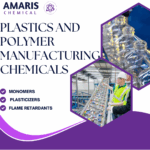
 Antioxidants(plastic)
Antioxidants(plastic) Colorants (Pigments, Dyes)
Colorants (Pigments, Dyes) Fillers and Reinforcements
Fillers and Reinforcements Flame Retardants
Flame Retardants Monomers
Monomers Plasticizers
Plasticizers Polymerization Initiators
Polymerization Initiators Stabilizers (UV, Heat)
Stabilizers (UV, Heat)
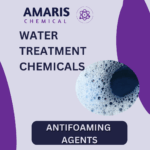 Antifoaming Agents
Antifoaming Agents Chelating Agents
Chelating Agents Coagulants and Flocculants
Coagulants and Flocculants Corrosion Inhibitors
Corrosion Inhibitors Disinfectants and Biocides
Disinfectants and Biocides Oxidizing Agents
Oxidizing Agents pH Adjusters
pH Adjusters Scale Inhibitors( water)
Scale Inhibitors( water)
 Antioxidants(cosmetic)
Antioxidants(cosmetic) Emollients
Emollients Fragrances and Essential Oils
Fragrances and Essential Oils Humectants
Humectants Preservatives
Preservatives Surfactants(cosmetic)
Surfactants(cosmetic) Thickeners
Thickeners UV Filters
UV Filters
 Fertilizers
Fertilizers Soil Conditioners
Soil Conditioners Plant Growth Regulators
Plant Growth Regulators Animal Feed Additives
Animal Feed Additives Biostimulants
Biostimulants Pesticides (Herbicides, Insecticides, Fungicides)
Pesticides (Herbicides, Insecticides, Fungicides)
 Active Pharmaceutical Ingredients (APIs)
Active Pharmaceutical Ingredients (APIs) Excipients
Excipients Solvents(pharmaceutical)
Solvents(pharmaceutical) Antibiotics
Antibiotics Antiseptics and Disinfectants
Antiseptics and Disinfectants Vaccine Adjuvants
Vaccine Adjuvants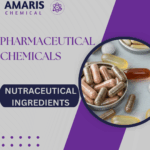 Nutraceutical Ingredients (pharmaceutical)
Nutraceutical Ingredients (pharmaceutical) Analgesics & Antipyretics
Analgesics & Antipyretics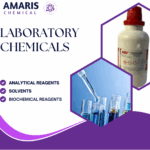
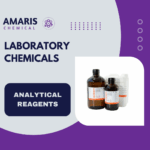 Analytical Reagents
Analytical Reagents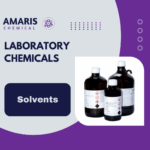 Solvents(lab)
Solvents(lab)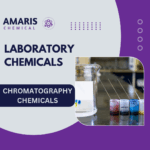 Chromatography Chemicals
Chromatography Chemicals Spectroscopy Reagents
Spectroscopy Reagents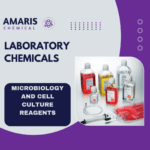 microbiology-and-cell-culture-reagents
microbiology-and-cell-culture-reagents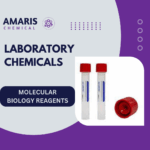 Molecular Biology Reagents
Molecular Biology Reagents Biochemical Reagents
Biochemical Reagents Inorganic and Organic Standards
Inorganic and Organic Standards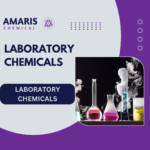 Laboratory Safety Chemicals
Laboratory Safety Chemicals Specialty Laboratory Chemicals(Special Laboratory Equipment)
Specialty Laboratory Chemicals(Special Laboratory Equipment)
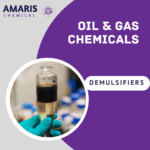 Demulsifiers
Demulsifiers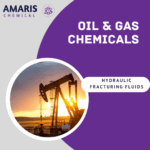 Hydraulic Fracturing Fluids
Hydraulic Fracturing Fluids Scale Inhibitors(oil)
Scale Inhibitors(oil) Surfactants(oil)
Surfactants(oil)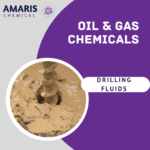 Drilling Fluids
Drilling Fluids
 Dyes and Pigments
Dyes and Pigments Bleaching Agents
Bleaching Agents Softening Agents
Softening Agents Finishing Agents
Finishing Agents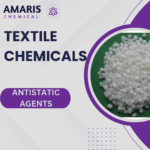 Antistatic Agents
Antistatic Agents
 Admixtures
Admixtures Waterproofing Agents
Waterproofing Agents Sealants and Adhesives
Sealants and Adhesives Curing Compounds
Curing Compounds Concrete Repair Chemicals
Concrete Repair Chemicals Anti-Corrosion Coatings
Anti-Corrosion Coatings
 Surfactants(cleaning)
Surfactants(cleaning) Builders
Builders Enzymes
Enzymes Solvents (Cleaning)
Solvents (Cleaning) Fragrances
Fragrances
 Electronic Chemicals
Electronic Chemicals Catalysts
Catalysts Lubricants
Lubricants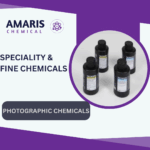 Photographic Chemicals
Photographic Chemicals Refrigerants
Refrigerants Automotive chemicals
Automotive chemicals Pyrotechnic Chemicals
Pyrotechnic Chemicals
 Biodegradable Surfactants
Biodegradable Surfactants Bio-based Solvents
Bio-based Solvents Renewable Polymers
Renewable Polymers Carbon Capture Chemicals
Carbon Capture Chemicals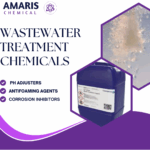 Wastewater Treatment Chemicals
Wastewater Treatment Chemicals
 Pigments
Pigments Solvents(paint)
Solvents(paint) Specialty Coatings
Specialty Coatings Binders/Resins
Binders/Resins Additives
Additives Driers
Driers Anti-Corrosion Agents
Anti-Corrosion Agents Functional Coatings
Functional Coatings Application-Specific Coatings
Application-Specific Coatings
 Fresh Herbs
Fresh Herbs Ground Spices
Ground Spices Whole Spices
Whole Spices Spice Blends
Spice Blends Dried Herbs
Dried Herbs
 Leavening Agents
Leavening Agents Dough Conditioners
Dough Conditioners Flour Treatments
Flour Treatments Fat Replacers
Fat Replacers Decoratives
Decoratives Preservatives(baking)
Preservatives(baking)
 Plasticizers & Softeners
Plasticizers & Softeners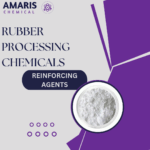 Reinforcing Agents
Reinforcing Agents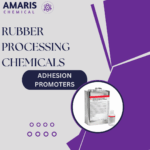 Adhesion Promoters
Adhesion Promoters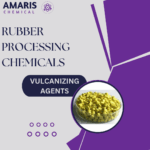 Vulcanizing Agents
Vulcanizing Agents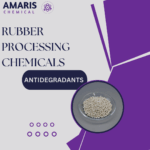 Antidegradants
Antidegradants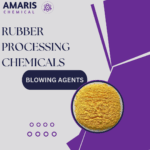 Blowing Agents
Blowing Agents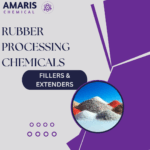 Fillers & Extenders
Fillers & Extenders Accelerators & Retarders
Accelerators & Retarders